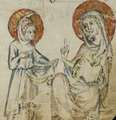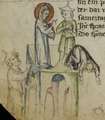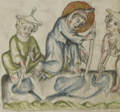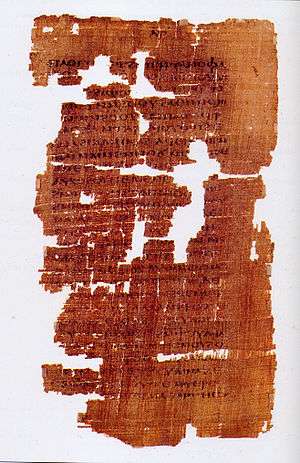Infancy Gospel of Thomas
The Infancy Gospel of Thomas is a biographical gospel about the childhood of Jesus, believed to date at the latest to the second century. It does not form part of any biblical canon.
| Infancy Gospel of Thomas | |
|---|---|
 Young Jesus brings clay birds to life | |
| Information | |
| Religion | Christianity (Gnosticism) |
| Author | "Thomas the Israelite" |
| Language | Greek |
| Period | Early Christianity (2nd Century) |
 |
|
|
|
|
|
Influenced by |
The Infancy Gospel of Thomas is thought to be Gnostic in origin. Later references (by Hippolytus of Rome and Origen of Alexandria) to a "Gospel of Thomas" are not at all referring to this Infancy Gospel, as many modern scholars have thought, but rather to the wholly different Gospel of Thomas.
Proto-orthodox Christians regarded the Infancy Gospel of Thomas as inauthentic and heretical. Eusebius rejected it as a heretical "fiction" in the third book of his fourth-century Church History, and Pope Gelasius I included it in his list of heretical books in the fifth century.
Although non-canonical in mainstream Christianity, the Infancy Gospel of Thomas contains many miracles and stories of Jesus referenced in the Qur'an, such as Jesus giving life to clay birds.
Dating
The first known quotation of the Infancy Gospel of Thomas is from Irenaeus of Lyon around AD 185. The earliest possible date of authorship is in the 80s AD, which is the approximate date of the Gospel of Luke, from which the author of the Infancy Gospel borrowed the story of Jesus in the temple at age 12 (see Infancy 19:1–12 and Luke 2:41–52). Scholars generally agree on a date in the mid- to late-2nd century AD. There are two 2nd-century documents, the Epistula Apostolorum and Irenaeus' Adversus haereses, that refer to a story of Jesus's tutor telling him, "Say alpha," and Jesus replying, "First tell me what is beta, and I can tell you what alpha is." At least some period of oral transmission of the text is generally believed to have occurred, either wholly or as several different stories before it was first redacted and transcribed. Thus, both of these documents and the Infancy Gospel of Thomas possibly all refer to the oral versions of this story.
Manuscript tradition
Whether the original language of the Infancy Gospel of Thomas was Greek or Syriac is unknown. The few surviving Greek manuscripts provide no clues themselves because none of them dates before the 13th century, whereas the earliest authorities, according to the editor and translator Montague Rhodes James, are a much abbreviated sixth-century Syriac version, and a Latin palimpsest of the fifth or sixth century, which has never been fully translated and can be found in Vienna.[1] Many manuscripts, translations, shortened versions, alternates, and parallels have slight, nuanced differences. James found that their large number makes the accounting of which text was which very difficult. This number of texts and versions reflects the great popularity of the work during the High Middle Ages.
Of the many different versions and alternate forms (e.g. Greek, Syriac, Latin, Slavonic, etc), the three principal forms are commonly referred to as given by Constantin von Tischendorf. Two of those are Greek texts which are called Greek Text A (Greek A); Greek Text B (Greek B); and the third is Latin.[2] The first known publication of the Infancy Gospel of Thomas was by J Fabricius and has come to be known as Greek A.[3] The Greek A is the most well-known form often used and in its full form is the longer of the two greeks, based on at least 2 manuscripts it consists of nineteen chapters with several alternate other manuscripts with abbreviated forms.[4] The Greek B was found by Tischendorf trip to Mount Sinai in 1844 which is not only shorter (11 chapters), but is a different version of the well-known A text. With some chapters abbreviated, other entire chapters left out completely, and few new lines.[5] The Latin translations has two distinct form of versions from the Old Latin with the Late Latin. The Latin was notable as it was the first discovered with an Egyptian prologue.[6]
Content
The text describes the life of the child Jesus, with fanciful, and sometimes malevolent, supernatural events, comparable to the trickster nature of the god-child in many Greek myths. One of the episodes involves Jesus making clay birds, which he then proceeds to bring to life, an act also attributed to Jesus in Quran 5:110,[7] and in a medieval work known as Toledot Yeshu, although Jesus's age at the time of the event is not specified in either account. In another episode, a child disperses water that Jesus has collected. Jesus kills this first child, when at age one he curses a boy, which causes the child's body to wither into a corpse. Later, Jesus kills another child when Jesus curses him when he apparently accidentally bumps into Jesus, throws a stone at Jesus, or punches Jesus (depending on the translation).
When Joseph and Mary's neighbours complain, they are miraculously struck blind by Jesus. Jesus then starts receiving lessons, but arrogantly tries to teach the teacher, instead, upsetting the teacher who suspects supernatural origins. Jesus is amused by this suspicion, which he confirms, and revokes all his earlier apparent cruelty. Subsequently, he resurrects a friend who is killed when he falls from a roof, and heals another who cuts his foot with an axe.
After various other demonstrations of supernatural ability, new teachers try to teach Jesus, but he proceeds to explain the law to them, instead. Another set of miracles is mentioned in which Jesus heals his brother, who is bitten by a snake, and two others, who have died from different causes. Finally, the text recounts the episode in Luke in which Jesus, aged 12, teaches in the temple.
Although the miracles seem quite randomly inserted into the text, three miracles are before and three are after each of the sets of lessons. The structure of the story is essentially:
- Bringing life to a dried fish (this is only present in later texts)
- (First group)
- 3 Miracles - Breathes life into birds fashioned from clay, curses a boy, who then becomes a corpse (not present in Greek B), curses a boy who falls dead and his parents become blind
- Attempt to teach Jesus which fails, with Jesus doing the teaching
- 3 Miracles - Reverses his earlier acts (this would include resurrecting the two boys and healing the blind parents), resurrects a friend who fell from a roof, heals a man who chopped his foot with an axe.[8]
- (Second group)
- Three Miracles - carries water on cloth, produces a feast from a single grain, stretches a beam of wood to help his father finish constructing a bed
- Attempts to teach Jesus, which fail, with Jesus doing the teaching
- Three Miracles - heals James from snake poison, resurrects a child who died of illness, resurrects a man who died in a construction accident
- Incident in the temple paralleling Luke
Episodes from Jesus's childhood as depicted in the Klosterneuburger Evangelienwerk, a 14th-century gospel translation:
 Jesus is carrying water in his lap, after his water jar got broken; other children are watching in surprise.
Jesus is carrying water in his lap, after his water jar got broken; other children are watching in surprise. Jesus hands the water in his lap over to Mary.
Jesus hands the water in his lap over to Mary. Jesus reassembles the water jars of the children who, in an attempt to imitate him, smashed their jars on purpose.
Jesus reassembles the water jars of the children who, in an attempt to imitate him, smashed their jars on purpose. Jesus raises the clay birds of his playmates to life.
Jesus raises the clay birds of his playmates to life. Jesus tells Joseph to raise a dead man.
Jesus tells Joseph to raise a dead man. Joseph raises the man on the stretcher from the dead.
Joseph raises the man on the stretcher from the dead. During play, child Zenon falls off the roof of a house; two Jews accuse Jesus to have pushed him.
During play, child Zenon falls off the roof of a house; two Jews accuse Jesus to have pushed him. Jesus raises the dead child from the dead, so he can testify that Jesus is innocent.
Jesus raises the dead child from the dead, so he can testify that Jesus is innocent. Together with other children, Jesus is catching fish on Sabbath.
Together with other children, Jesus is catching fish on Sabbath. A Jew who scolds the children dies on the spot.
A Jew who scolds the children dies on the spot. The children complain about Jesus to adult Jews.
The children complain about Jesus to adult Jews. At Mary's and Joseph's request, Jesus raises the dead man.
At Mary's and Joseph's request, Jesus raises the dead man. Jesus plays with lions and guides them up to the town gates. The town people are scared.
Jesus plays with lions and guides them up to the town gates. The town people are scared. Jesus quarrels with his teacher in front of other pupils about the nature of the letters.
Jesus quarrels with his teacher in front of other pupils about the nature of the letters.
Syriac Infancy Gospel
The Syriac Infancy Gospel (Injilu 't Tufuliyyah), translated from a Coptic original, gives some parallels to the episodes "recorded in the book of Josephus the Chief Priest, who was in the time of Christ."
Further reading
- Barnstone, Willis (ed.). The Other Bible, Harper Collins, 1984, pp. 398–403. ISBN 0-06-250031-7
References
- James, M.R. (1924). Christian Apocrypha and Early Christian Literature (PDF). Oxford: Clarendon Press. p. 276.
- James, M.R. (1924). Christian Apocrypha and Early Christian Literature (PDF). Oxford: Clarendon Press. p. 276.
- van Aarde, A.G. (2005). "The infancy Gospel of Thomas: Allegory or myth - Gnostic or Ebionite?" (PDF). University of Pretoria. p. 3 (p. 828).
- Burke, Tony. "Infancy Gospel of Thomas: Greek A". TonyBurke.ca. Retrieved 11 January 2019.
- Burke, Tony. "Infancy Gospel of Thomas: Greek B". TonyBurke.ca. Retrieved 11 January 2019.
- Burke, Tony. "Infancy Gospel of Thomas: Late Latin". TonyBurke.ca. Retrieved 11 January 2019.
- Kate Zebiri of the University of London (Spring 2000). "Contemporary Muslim Understanding of the Miracles of Jesus" (PDF). The Muslim World. Hartford Seminary's Macdonald Center for the Study of Islam and Christian-Muslim Relations. 90: 74. Archived from the original (PDF) on 2010-07-09. Retrieved 2010-01-04.
In the Qur'an, the miracles of Jesus are described in two passages: 3:49 and 5:110. Qur'an 3:49 attributes the following words to Jesus: I have come to you, with a Sign from your Lord, in that I make for you of clay, the figure of a bird, and breathe into it, and it becomes a bird by God's permission
- Gospel of Thomas Greek Text A(Archive), Wesley Center Online, Northwest Nazarene University
External links
| Wikisource has original text related to this article: |
- Early Christian Writings: Infancy Gospel of Thomas
- Gnostic Society Library: Infancy Gospel of Thomas introduction and translations by M.R. James, 1924
